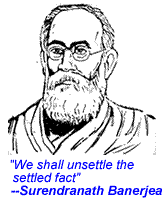
Dimdima
Online Children's Magazine from India

Dimdima
Online Children's Magazine from India
| Partition of Bengal |
|
|
 But
the British paid no heed to the sentiments of the people and the partition of
Bengal became a reality on October 10, 1905. The British probably thought the
people would accept it as a fait accompli and set aside their agitation. But
they were proved wrong. Instead of dying out, the campaign against partition
became intensified.
But
the British paid no heed to the sentiments of the people and the partition of
Bengal became a reality on October 10, 1905. The British probably thought the
people would accept it as a fait accompli and set aside their agitation. But
they were proved wrong. Instead of dying out, the campaign against partition
became intensified.
The idea of boycotting British goods spread like wildfire through Bengal and
then to different parts of the country. In many places, people not only decided
not to buy foreign goods but also to burn all the foreign goods they already
possessed. The boycott was given a new dimension when people imposed a social
boycott on those who were reluctant to switch over to Swadeshi.
The boycott was extended to the British system of education too. National
education was offered with the opening of national schools, national colleges
and rashtriya vidyalayas in different parts of the country.
Indian literature, music and the arts of that period reflected the spirit of
Swadeshi. The Swadeshi spirit had its impact on science and industry too.
The agitation against the partition of Bengal did not remain confined to Bengal.
It spread to all parts of the country and for the first time the people of India
behaved like the people of one nation. Such a thing had never happened before
since the arrival of the British, not even during the great uprising of 1857,
when the non-combatants had remained mere spectators and the South, largely
unsympathetic. This time people from Punjab to Madras and from Bombay to
Calcutta were caught up in the mood of rebellion.
1905 was, therefore, clearly a watershed in the history of the Independence
movement. Before 1905, all protests against British rule were isolated
developments. After 1905, the movement against the British assumed national
dimensions.
Instead of dividing the people, the partition of Bengal united a nation. In the
words of Abdul Rasul, president of Barisal Conference in 1906 : "What we could
not have accomplished in 50 or 100 years, the great disaster, the Partition of
Bengal, has done for us in six months."
Dimdima is the Sanskrit word for ‘drumbeat’. In olden days, victory in battle was heralded by the beat of drums or any important news to be conveyed to the people used to be accompanied with drumbeats.
Bharatiya Vidya Bhavan
K. M Munshi Marg,
Chowpatty, Mumbai - 400 007
email : editor@dimdima.com
Bharatiya Vidya Bhavan
505, Sane Guruji Marg,
Tardeo, Mumbai - 400 034
email : promo@dimdima.com
Dimdima.com, the Children's Website of Bharatiya Vidya Bhavan launched in 2000 and came out with a Printed version of Dimdima Magazine in 2004. At present the Printed Version have more than 35,000 subscribers from India and Abroad.